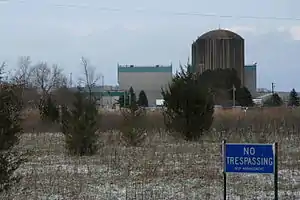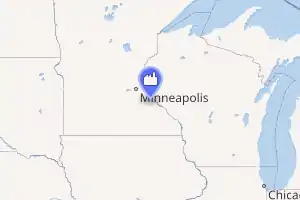Prairie Island Nuclear Power Plant
The Prairie Island Nuclear Generating Plant is an electricity-generating facility located in Red Wing, Minnesota along the Mississippi River, and adjacent to the Prairie Island Indian Community reservation.
| Prairie Island Nuclear Power Plant | |
|---|---|
 Prairie Island Nuclear Generating Plant in April 2011 | |

| |
| Official name | Prairie Island Nuclear Generating Station, Prairie Island Nuclear Generating Plant |
| Country | United States |
| Location | Red Wing, Goodhue County, Minnesota |
| Coordinates | 44°37′18″N 92°37′59″W |
| Status | Operational |
| Construction began | Unit 1: June 25, 1968 Unit 2: June 25, 1969 |
| Commission date | Unit 1: December 16, 1973 Unit 2: December 21, 1974 |
| Construction cost | $993.3 million (2007 USD)[1] |
| Owner(s) | Xcel Energy |
| Operator(s) | Northern States Power Company |
| Nuclear power station | |
| Reactor type | PWR |
| Reactor supplier | Westinghouse |
| Cooling towers | 4 × Mechanical Draft |
| Cooling source | Mississippi River |
| Thermal capacity | 2 × 1677 MWth |
| Power generation | |
| Units operational | 1 × 522 MW 1 × 519 MW |
| Make and model | WH 2-loop (DRYAMB) |
| Nameplate capacity | 1041 MW |
| Capacity factor | 95.90% (2017) 86.75% (lifetime) |
| Annual net output | 8745 GWh (2017) |
| External links | |
| Website | Prairie Island Nuclear Generating Station |
| Commons | Related media on Commons |
The nuclear power plant, which began operating in 1973, has two nuclear reactors (pressurized water reactors) manufactured by Westinghouse that produce a total 1,076 megawatts of power. Units 1 and 2 are licensed by the Nuclear Regulatory Commission (NRC) to operate through 2033 and 2034, respectively. The plant is owned by Northern States Power Company (NSP), a subsidiary of Xcel Energy, and is operated by Xcel Energy.
Prairie Island is one of two nuclear power plants in Minnesota (the other being Monticello Nuclear Generating Plant in Monticello). Prairie Island has attracted controversy in the early 21st century for its operator Xcel Energy's decision to store nuclear waste in large steel casks on-site. As this area is a floodplain of the Mississippi, many opponents of the decision fear the risk of water contamination through breach of the casks during seasonal flooding of this important river. They opposed renewal of the federal license at the Prairie Island facility.
In April 2008, Xcel requested that the U.S. Nuclear Regulatory Commission (NRC) renew the licenses of both reactors, extending them for an additional twenty years. The license renewals were approved in June 2011.[2][3]
The company has also requested NRC approval to use a similar storage system at its Monticello plant, which is currently licensed through 2030.
In May 2006 repair workers at the plant were exposed to very low levels of radiation due to inhalation of radioactive iodine-131 (131I) gas. The gas leaked from the steam generators, which were opened for inspection. 131I gas is normally removed by means of a carbon-based filter; in this case the filter had developed a small leak. The NRC deemed this event to be of very low safety significance. It said that no overdose of radiation resulted in any of the workers.[4]
Surrounding population
The Nuclear Regulatory Commission defines two emergency planning zones around nuclear power plants: a plume exposure pathway zone has a radius of 10 miles (16 km), and is related primarily to exposure to, and inhalation of, airborne radioactive contamination. Secondly, an ingestion pathway zone with a radius of about 50 miles (80 km), is concerned primarily with ingestion of food and liquid by residents that could be contaminated by radioactivity.[5]
The 2010 U.S. population within 10 miles (16 km) of Prairie Island was 27,996, an increase of 4.6 percent in a decade, according to an analysis of U.S. Census data for MSNBC. The 2010 U.S. population within 50 miles (80 km) was 2,945,237, an increase of 7.8 percent since 2000. Cities within 50 miles include Minneapolis (39 miles to city center) and St. Paul (32 miles to city center).[6]
Spent fuel storage
NSP had initially intended to send radioactive waste from this plant to a storage facility operated by the United States federal government, but no such site is yet open for use. (The Yucca Mountain nuclear waste repository is under construction, but given strong opposition in the region, the Obama Administration no longer thought this was an option.)
In 1991, Xcel Energy had requested permission from the Minnesota Public Utilities Commission to eventually store waste in 48 dry casks on the Prairie Island site. Opposition by environmentalists and the neighboring Prairie Island tribe led the Minnesota Legislature to decrease the number of allowed casks to 17; this was sufficient to keep the plant operating through approximately 2003.[7]
When those casks filled, Xcel Energy requested that the limit be expanded beyond 17 casks. The legislature granted the request, but required the company to make greater use of renewable energy in generating power, such as wind power. In addition, it was required to pay the adjacent Prairie Island Community up to $2.25 million per year to help with evacuation improvements, and the acquisition and development of new land for their reservation. In addition, this money was to help pay for a health study and emergency management activities by the small tribe.
Steam generator replacement
Operators at Prairie Island Nuclear Generating Plant began a refueling outage on Unit 2 at 12:01 a.m. 9/23/2013. In addition to refueling the reactor, an expanded workforce replaced the unit's two steam generators.[8] Unit 2 was expected to come back online within eight weeks; however, it did not resume operation until January 13, 2014. At 2 AM on January 14th, Unit 2 reached 100% power output.[9]
Seismic risk
The Nuclear Regulatory Commission's estimate of the risk each year of an earthquake intense enough to cause core damage to the reactor at Prairie Island was 1 in 333,333, according to an NRC study published in August 2010.[10][11]
Emergency shutdowns
Xcel Energy performed an emergency shutdown in late January 2015 of the Unit 1 reactor after a cloud of steam built up in the pressurized cooling system following a cooling-down process to replace a seal in one of the reactor cooling pumps. The plant returned to full power in February 2015.[12]
Unit 2 of the plant has been shutdown due to an emergency on 5 March 2015, indicated by a fire alarm at 4:00 am CST. Xcel energy plant operators declared a “notification of an unusual event,” the lowest of four emergency classifications established by the U.S. Nuclear Regulatory Commission.[13]
Unit 2 shut down automatically Dec 17, 2015 due to a turbine problem, and the fire alarm went off at the time. Operators declared a "notification of unusual event".[14]
References
- "EIA - State Nuclear Profiles". www.eia.gov. Retrieved 3 October 2017.
- "Prairie Island Nuclear Generating Plant, Units 1 and 2 - License Renewal Application". Nuclear Regulatory Commission. Retrieved 16 March 2011.
- Karnowski, Steve (June 28, 2011). "Prairie Island nuclear plant licenses renewed". Associated Press. Retrieved 30 June 2011.
- 4Q/2007 Inspection Findings - Prairie Island 2
- "Backgrounder on Emergency Preparedness at Nuclear Power Plants". Nuclear Regulatory Commission. Retrieved 2019-12-22.
- Bill Dedman, "Nuclear neighbors: Population rises near US reactors", NBC News, 14 April 2011; Accessed May 1, 2011.
- "Another Nuclear Rip-off: Unmasking Private Fuel Storage" (PDF). citizen.org. July 2001. Retrieved 2 August 2020.
- "Prairie Island Unit 2 Begins Refueling Outage", News Release, Xcel Energy
- Shaffer, David (2014-01-15). "Prairie Island nuclear plant is back online". Star Tribune. Retrieved 2019-12-22.
- Bill Dedman, "What are the odds? US nuke plants ranked by quake risk," NBC News, March 17, 2011 http://www.nbcnews.com/id/42103936 Accessed April 19, 2011.
- "Archived copy" (PDF). Archived from the original (PDF) on 2017-05-25. Retrieved 2011-04-19.CS1 maint: archived copy as title (link)
- "Prairie Island Nuclear Power Plant 1 returns to full power" Archived 2015-04-02 at the Wayback Machine, FOX 28 News
- "Prairie Island Nuclear Plant unit shut down", CBS Local, Minnesota, 5 March 2015
- , The Public
External links
| Wikimedia Commons has media related to Prairie Island Nuclear Generating Plant. |
- "Prairie Island Nuclear Plant, Minnesota". Energy Information Administration, U.S. Department of Energy (DOE). August 29, 2008. Archived from the original on May 27, 2012. Retrieved 2008-11-22.
- "Prairie Island 1 Pressurized Water Reactor". Operating Nuclear Power Reactors. U.S. Nuclear Regulatory Commission (NRC). February 14, 2008. Retrieved 2008-11-22.
- "Prairie Island 2 Pressurized Water Reactor". Operating Nuclear Power Reactors. NRC. February 14, 2008. Retrieved 2008-11-22.
- Prairie Island Coalition – a group opposing the storage of reactor waste
- Nuclear Tourist: Prairie Island Nuclear Power Plant
- Minnesota Legislative Reference Library: Prairie Island Nuclear Waste Storage